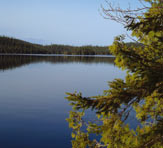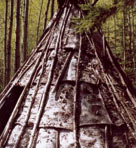|
|
  |
|
| |
Institutions > Aboriginal Co-management of Forests |
| |
By "institutions" we generally refer to structures and rules that make up the forest management system of a given jurisdiction -- also called "institutional arrangements". While people also often use "institutions" to mean "organizations", that is not the primary meaning intended here. |
| |
|
| |
Mabee, H.S., and G. Hoberg. 2006. Equal partners? Assessing comanagement of forest resources in Clayoquot Sound. Society and Natural Resources 19(10): 875-888. |
| |
"Using a case study of Clayoquot Sound, this article examines progress and challenges with creating an equal partnership in a case of comanagement of forest resources between indigenous peoples and the state in Canada. The analysis of participants' perceptions revealed a need for careful definition of key terms used in comanagement arrangements to ensure shared understanding and interpretation of goals among the parties, especially given the different worldviews and knowledge systems used by the two parties. In addition, it was found that equality must be analyzed separately for each key function of comanagement, as different factors are involved. Equality in decision making was constrained primarily by the structure of statutory authority, whereas equality in planning was constrained by the capacity gap. Although truly “equal” comanagement has not been achieved in Clayoquot Sound, positive benefits of relationship building and cross-cultural exchange have developed. " (Abstract) |
| |
|
| |
Grainger, S., E. Sherry, and G. Fondahl. The John Prince Research Forest: Evolution of a co-management partnership in northern British Columbia. The Forestry Chronicle 82(4):484-495. |
| |
The John Prince Research Forest (JPRF) was established as a co-managed forest between Tl'azt'en Nation and the University of Northern British Columbia, as an opportunity for these partners to blend thieir respective ways of understanding and managing forests to contribute to ecological and social sustainability. Using four criteria of successful co-management reported in the literature as critical to the early stages of partnership -- partnership buidling institutional structure, decision-making, and capacity -- we discuss the JPRF's performance during the first half-decade of its existence. The JPRF's early experience provides an example of the evolution of a co-management relationship that, while facing constraints and challenges in regard to some of the criteria, has provided the foundation for a strong future partnership. |
| |
Roberts, K. 1996. Circumpolar Aboriginal people and co-management practice. Conference proceedings. University of Calgary Arctic Institute. |
| |
Central Region Board (Central Region Nuu-chah-nulth and Province of BC) |
| |
"Central Region Board (CRB), established under an Interim Measures Agreement between the Hereditary Chiefs of the Nuu-chah-nulth Central Region and the Province of British Columbia (the Parties), is a joint management process that oversees development in Clayoquot Sound.
The CRB serves as a link between the BC government, First Nations and other local communities. The Board has the responsibility of reviewing plans produced by any BC agency or ministry empowered to make resource management and land use decisions. The CRB ensures that First Nations and local perspectives are brought to bear in decisions regarding development in Clayoquot Sound. When considering issues, the Board strives to see a broad picture (the Nuu-chah-nulth concept of
Hishuk ish ts'awalk or "everything is one"). The social, economic and environmental concerns of First Nations and local communities are addressed in the review of proposals, applications, and strategic plans brought to the Board. All meetings of the CRB are open to the public." (from website) |
| |
The Timber Fish & Wildlife Agreement and the Forests and Fish Report (Washington State) |
| |
The landmark 1987 Timber, Fish, and Wildlife Agreement was triggered by environmentalist protests and a landmark court decision that confirmed American Indians' rights to protect the habitat of salmon and other fish to which they hold treaty rights of harvest. As a result, the forest sector of Washington State underwent a radical restructuring of power relationships and access to decision-making and scientific research. Since that time, the process has evolved into an elaborate system of scientific and policy forums. The most recent major event has been the listing of several salmon populations under the Endangered Species Act of the USA, thus triggering a requirement for habitat conservation planning to ensure their survival. The forest sector's response in Washington State was the Forests and Fish Report of 1999, and a series of legislative, policy, and scientific instruments to implement it.
There is no single source that provides easy access to the complex history of this policy forum, and the Aboriginal aspect is seldom given a strong focus. Call (2005) analyzes the lessons for collaborative processes in this case. Kepkay (2003) provides an overview of this history, although with an emphasis on theoretical perspectives on adaptive management and complex systems. The Washington State Department of Natural Resources website provides access to the adaptive management components under the Forests and Fish Report. The State Department of Fish and Wildlife website provides information about the habitat science and protection aspect of the policies. |
| |
|
|
|


